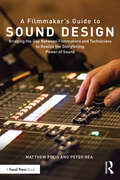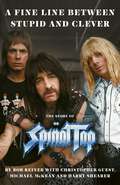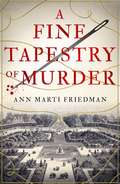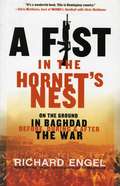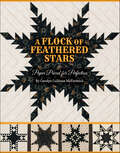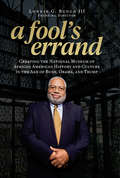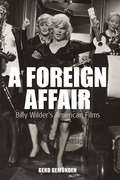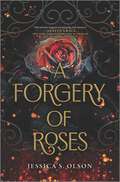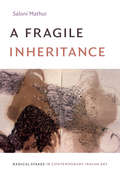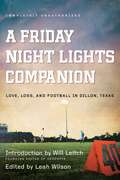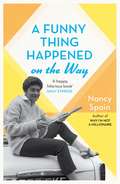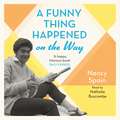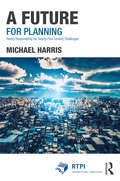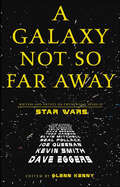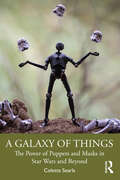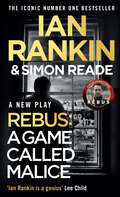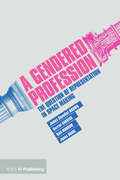- Table View
- List View
A Filmmaker’s Guide to Sound Design: Bridging the Gap Between Filmmakers and Technicians to Realize the Storytelling Power of Sound
by Peter Rea Matthew PolisThis illuminating book offers a unique view into the art of sound design and the post production audio process. It was written for filmmakers and designed to bridge the creative gap between directors, producers and the artists, and technicians who are responsible for creating the full soundtrack. Building on over 50 years of combined expertise in teaching, filmmaking, and sound design, experienced instructor and author Peter Rea and sound designer Matthew Polis offer a cogent, clear, and practical overview of sound design principles and practices, from exploring the language and vocabulary of sound to teaching readers how to work with sound professionals and later to overseeing the edit, mix, and finishing processes. In this book, Polis and Rea focus on creative and practical ways to utilize sound in order to achieve the filmmaker's vision and elevate their films. Balancing practical, experienced-based insight, numerous examples, and unique concepts like storyboarding for sound, A Filmmaker’s Guide to Sound Design arms students, filmmakers, and educators with the knowledge to creatively and confidently navigate their film through the post audio process.
A Fine Line Between Stupid and Clever: The Story of Spinal Tap
by Rob ReinerFor the first time, director Rob Reiner and cocreators Christopher Guest, Michael McKean, and Harry Shearer provide the full behind-the-scenes story of the making of the groundbreaking mockumentary This Is Spinal Tap and its upcoming sequel. <P><P> Since its original release in 1984, This Is Spinal Tap has evolved from a beloved cult film into a cinematic landmark: an all-time comedy classic that pioneered an entire genre, the mockumentary. Now, director Rob Reiner and his cowriters and costars, Christopher Guest, Michael McKean, and Harry Shearer, tell the complete story of the movie and its fictitious band—how they met, how Spinal Tap came to be, and how their low-budget indie film took on a life of its own. <P><P> Years after the movie first came out, the Library of Congress selected This Is Spinal Tap for inclusion in the National Film Registry and Tap went on to play The Royal Albert Hall, Wembley Stadium, and to over 100,000 fans at the Glastonbury Festival in England. <P><P> Reiner, Guest, McKean, and Shearer provide the backstories to the movie’s famous lines—among them “Hello, Cleveland!,” “None more black,” “You can’t dust for vomit,” and “These go to eleven”—and to such Tap anthems as “Big Bottom” and “Stonehenge.” <P><P> Featuring never-before-seen photographs, band memorabilia, and personal reminiscences of their enduring creative partnership, A Fine Line Between Stupid and Clever will delight Tap-heads of all ages—just as the long-awaited Spinal Tap sequel is hitting theaters. <P><P> BUT WAIT, THERE’S MORE! A Fine Line Between Stupid and Clever also comes with a bonus memoir by Reiner’s directorial alter ego, Marty DiBergi, in which he interviews Tap band members Nigel Tufnel, David St. Hubbins, and Derek Smalls about their musical journey and their drummers who paid the ultimate sacrifice to the rock gods. <P><P> <B>New York Times Bestseller</B>
A Fine Line between Stupid and Clever: The Story of Spinal Tap
by Rob ReinerFor the first time, director Rob Reiner and co-creators Christopher Guest, Michael McKean and Harry Shearer provide the full behind-the-scenes story of the making of the groundbreaking mockumentary This Is Spinal Tap and its upcoming sequel. Since its original release in 1984, This Is Spinal Tap has evolved from a beloved cult film into a cinematic landmark: an all-time comedy classic that pioneered an entire genre: the mockumentary. Now, director Rob Reiner and his co-writers and co-stars, Christopher Guest, Michael McKean and Harry Shearer, tell the complete story of the movie and its fictitious band – how they met, how Spinal Tap came to be, and how their low-budget indie film took on a life of its own. Years after the movie first came out, the Library of Congress selected This Is Spinal Tap for inclusion in the National Film Registry and Tap went on to play the Royal Albert Hall, Wembley Stadium, and to over 100,000 fans at Glastonbury. Reiner, Guest, McKean and Shearer provide the backstories to the movie&’s famous lines – among them 'Hello, Cleveland!,' 'None more black,' 'You can&’t dust for vomit' and 'These go to eleven' – and to such Tap anthems as 'Big Bottom' and 'Stonehenge'. Featuring never-before-seen photographs, band memorabilia and personal reminiscences of their enduring creative partnership, A Fine Line Between Stupid and Clever will delight Tap-heads of all ages – just as the long-awaited Spinal Tap sequel is hitting theatres. BUT WAIT, THERE&’S MORE! A Fine Line Between Stupid and Clever also comes with a bonus memoir by Reiner&’s directorial alter ego, Marty DiBergi, in which he interviews Tap band members Nigel Tufnel, David St. Hubbins and Derek Smalls about their musical journey and their drummers who paid the ultimate sacrifice to the rock gods.
A Fine Tapestry of Murder
by Ann Marti FriedmanA compelling historical murder mystery set amongst the artists in seventeenth-century Paris. For fans of C.J. Sansom and S.J. Parris. 'A rich and achingly beautiful novel' - Carol McGrath (author of the Daughters of Hastings trilogy) on An Artist in Her Own Right. Paris, 1676. When a body washes up on the banks of the Bièvre river, a young woman finds herself embroiled in an intricate murder case.At first it seems mere coincidence that the dead man was discovered outside the Royal Manufactory of the Gobelins, home to a community of artists and craftsmen. He was not one of them, after all. But Anne-Marie, a sculptor's wife, soon realises that the victim may well be known within the walls of the Gobelins - and that the killer might be amongst them.With the police apparently disinterested, it is a mystery that is hers alone to solve. Anne-Marie's investigations will take her from the unsavoury slums of the Ile Notre-Dame to the grand ducal residences of the Place Royale. But who can she truly trust on the streets of Paris?Readers LOVED An Artist in Her Own Right:'A wonderful blend of fact and fiction that I literally read in two sittings''Alive with action and colour''The ebb and flow of relationships, between family members and artists, are beautifully conceived and nuanced''Wonderful imaginative detail'
A Fire in His Soul: Van Gogh, Paris, and the Making of an Artist
by Miles J. UngerThe fascinating story of Vincent van Gogh&’s two groundbreaking years in Paris, where he transformed himself from a provincial unknown into one of the world&’s great visionary artists.Vincent Van Gogh arrived in the French capital on the last day of February 1886, a month short of his thirty-third birthday. He was a man beaten down by life, half-starved, and nearly broken psychologically. He was saved by his brother Theo, who provided him with room, board, and, most crucially, emotional support while he attempted to master the difficult craft of painting. Thus far, Vincent's crude scenes of peasant life rendered in murky shades of brown and gray were both hackneyed and amateurish. Theo, a successful art dealer at a prestigious Parisian firm, dismissed them as gloomy, unappealing, and, worst of all, unmarketable. By the time Vincent left Paris, almost exactly two years later, he&’d transformed himself into one of the most original artists of the age, turning out works of hallucinatory intensity in vivid hues and stamped with his own distinctive personality. A Fire in His Soul chronicles this remarkable transformation. It&’s a tale filled with tragedy and triumph, personal anguish and creative fulfillment, as Vincent, through sheer force of will, reinvents himself as a painter of unparalleled expressive power. Along the way, the reader will discover an unfamiliar Van Gogh: not the solitary genius of the popular imagination, shunned by an uncomprehending world and conjuring masterpieces from the depths of his lonely soul. In Paris, he was at the center of a community of like-minded seekers. Here, Van Gogh was able to engage in a lively dialogue with fellow artists almost as daring as he was, expanding his notion of what art could and should be. It was in the cafes and studios of Montmartre and in the grand galleries of the Louvre and Luxembourg, that Van Gogh received his artistic education—a crash course that at first disoriented him but ultimately sparked his creative breakthrough. Working alongside such legendary figures as Gauguin, Toulouse-Lautrec, Seurat, and Signac, he found his voice and launched an artistic revolution.
A Fist in the Hornet's Nest: On the Ground in Baghdad Before, During & After the War
by Richard EngelWhen war broke out in Iraq, every major U.S. network pulled its correspondents from the scene. Despite the risk, Richard Engel stayed. As our tanks entered Baghdad in April 2003, he was there, bringing the Iraqi war into American homes as a stringer for ABC news. Determined to deliver the whole Middle East story, Engel moved to Cairo in 1996 after graduating from Stanford to learn 'street' Arabic. Then to dig even deeper into the complicated powder-keg of the Israeli-Palestinian conflict, he settled in Jerusalem.Now as Iraq enters its post-war phase and the Gulf region continues to dominate our nation's consciousness, more and more Americans will come to know and trust Richard Engel--especially in his current role as a correspondent for NBC Nightly News with Tom Brokaw. Both analytical and anecdotal, this book leads us through the war in Iraq, dissecting a myriad of Middle East issues, all from the vantage point of someone who is 'on the ground and in the streets' to get the real story.
A Flight of Butterflies
by Kanzaka SekkaExquisite full-color plates depict 216 winged beauties, soaring and drifting across the pages in apparently seamless flight. Also includes a bonus CD-ROM that features all of the royalty-free butterfly graphics, both in full "flights" and separated into individual units. Ideal for lovers of fine art and for use by graphic artists, designers, and craftworkers.
A Flock of Feathered Stars: Paper Pieced for Perfection
by Carolyn Cullinan McCormickI have always been so amazed by feathered star quilts, especially the quilts that were made in the 1800s. e quilter from the 1800s did not have the “tools” of today. ey made those fabulous quilts using a template made of whatever was available along with their fabric, needle, thread and scissors. My dear friend, Diane Donnelly, and I share a passion for old quilts. In 2009, she gave me a book called Quilts eir Story and How to Make em, written by Marie D. Webster in 1915. Seeing how excited I was with that book, she gave me another later that year called Romance of the Patchwork Quilt in America written by Carrie A. Hall and Rose G. Kretsinger in 1935. at was all the inspiration I needed to write a book on how to paper piece feathered stars. ( at is the only way to make a feathered star quilt … right?) Some of the designs in the books used pieces that nished at 1" or less, and I have to admit some of them were quite a challenge to dra . I wanted to get as many designs as possible into one quilt along with a border block (I had to have a border block) that I had seen on one of the quilts without making the book so big you couldn’t li it. I hope you like the selection of feathered star blocks I have chosen to include. Some of the blocks you may have seen before but others are designs that I think will be a pleasant surprise.
A Fool's Errand: Creating the National Museum of African American History and Culture in the Age of Bush, Obama, and Trump
by Lonnie G. Bunch IIIFounding Director Lonnie Bunch's deeply personal tale of the triumphs and challenges of bringing the Smithsonian National Museum of African American History and Culture to life. His story is by turns inspiring, funny, frustrating, quixotic, bittersweet, and above all, a compelling read.In its first four months of operation, the Smithsonian National Museum of African American History and Culture surpassed one million visits and quickly became a cherished, vital monument to the African American experience. And yet this accomplishment was never assured. In A Fool's Errand, founding director Lonnie Bunch tells his story of bringing his clear vision and leadership to bear to realize this shared dream of many generations of Americans. Outlining the challenges of site choice, architect selection, building design, and the compilation of an unparalleled collection of African American artifacts, Bunch also delves into his personal struggles--especially the stress of a high-profile undertaking--and the triumph of establishing such an institution without mentors or guidebooks to light the way. His memoir underscores his determination to create a museum that treats the black experience as an essential component of every American's identity.This inside account of how Bunch planned, managed, and executed the museum's mission informs and inspires not only readers working in museums, cultural institutions, and activist groups, but also those in the nonprofit and business worlds who wish to understand how to succeed--and do it spectacularly--in the face of major political, structural, and financial challenges.
A Foreign Affair
by Gerd GemundenWith six Academy Awards, four entries on the American Film Institute's list of 100 greatest American movies, and more titles on the National Historic Register of classic films deemed worthy of preservation than any other director, Billy Wilder counts as one of the most accomplished filmmakers ever to work in Hollywood. Yet how American is Billy Wilder, the Jewish émigré from Central Europe? This book underscores this complex issue, unpacking underlying contradictions where previous commentators routinely smoothed them out. Wilder emerges as an artist with roots in sensationalist journalism and the world of entertainment as well as with an awareness of literary culture and the avant-garde, features that lead to productive and often highly original confrontations between high and low.
A Forger's Tale: Confessions of the Bolton Forger
by Shaun GreenhalghIn 2007, Bolton Crown Court sentenced Shaun Greenhalgh to four years and eight months in prison for the crime of producing artistic forgeries. Working out of a shed in his parents' garden, Greenhalgh had successfully fooled some of the world's greatest museums. During the court case, the breadth of his forgeries shocked the art world and tantalised the media. What no one realised was how much more of the story there was to tell.Written in prison, A Forger's Tale details Shaun's notorious career and the extraordinary circumstances that led to it. From Leonardo drawings to L.S. Lowry paintings, from busts of American presidents to Anglo-Saxon brooches, from cutting-edge Modernism to the ancient art of the Stone Age, Greenhalgh could - and did - copy it all. Told with great wit and charm, this is the definitive account of Britain's most successful and infamous forger, a man whose love for art saturates every page of this extraordinary memoir.
A Forgery of Roses
by Jessica S. OlsonFrom the author of Sing Me Forgotten comes a lush new fantasy novel with an art-based magic system, romance, and murder… Myra has a gift many would kidnap, blackmail, and worse to control: she&’s a portrait artist whose paintings alter people&’s bodies. Guarding that secret is the only way to keep her younger sister safe now that their parents are gone. But one frigid night, the governor&’s wife discovers the truth and threatens to expose Myra if she does not complete a special portrait that would resurrect the governor's dead son. Once she arrives at the legendary stone mansion, however, it becomes clear the boy&’s death was no accident. A killer stalks these halls--one disturbingly obsessed with portrait magic. Desperate to get out of the manor as quickly as possible, Myra turns to the governor&’s older son for help completing the painting before the secret she spent her life concealing makes her the killer&’s next victim.
A Fragile Inheritance: Radical Stakes in Contemporary Indian Art
by Saloni MathurIn A Fragile Inheritance Saloni Mathur investigates the work of two seminal figures from the global South: the New Delhi-based critic and curator Geeta Kapur and contemporary multimedia artist Vivan Sundaram. Examining their written and visual works over the past fifty years, Mathur illuminates how her protagonists&’ political and aesthetic commitments intersect and foreground uncertainty, difficulty, conflict, and contradiction. This book presents new understandings of the culture and politics of decolonization and the role of non-Western aesthetic avant-gardes within the discourses of contemporary art. Through skillful interpretation of Sundaram's and Kapur&’s practices, Mathur demonstrates how received notions of mainstream art history may be investigated and subjected to creative redefinition. Her scholarly methodology offers an impassioned model of critical aesthetics and advances a radical understanding of art and politics in our time.
A Friday Night Lights Companion: Love, Loss, and Football in Dillon, Texas
by Jacob Clifton Jen ChaneyCalled one of the best shows on TV by more than a dozen media publications, including Time and Entertainment Weekly, Friday Night Lights is not just one of the most critically acclaimed shows on air, it's also one of the most watchable. Despite its focus on high school football, its masterfully crafted characters and honestly portrayed relationships make its portrait of small town Texas life compelling and relatable in ways that have nothing to do with field goals or touchdowns. Love, Loss, and Dillon Football: A Friday Night Lights Companion explores the victories and pitfalls of Dillon, Texas – both the town itself and those who live and love there. Because Friday Night Lights is so much more than just a teenage football drama: it's about the struggle to not get trapped in the circumstances one is born into. It's about love, it's about loss, and, yes, it's even about football.
A Funny Thing Happened On The Way: Discover the 1960s trend for buying land on a Greek island and building a house. How hard could it be…?
by Nancy Spain<p>The superb classic memoir from a dazzlingly eccentric and endlessly fascinating author and feminist icon - a woman very much ahead of her time - including her time spent on the glorious island of Skiathos<p> <p>Nancy Spain was one of the most celebrated - and notorious - writers and broadcasters of the 50s and 60s. Witty, controversial and brilliant, she lived openly as a lesbian (sharing a household with her two lovers and their various children) and was frequently litigated against for her newspaper columns - Evelyn Waugh successfully sued her for libel... twice.<p> <p>Nancy Spain had a deep love of the Mediterranean. So it was no surprise when, in the 1960s, she decided to build a place of her own on the Greek island of Skiathos. With an impractical nature surpassed only by her passion for the project, and despite many obstacles, she gloriously succeeded. This classic memoir is infused with all Spain's chaotic brilliance, zest for life and single-minded pursuit of a life worth living.<p>
A Funny Thing Happened On The Way: Discover the 1960s trend for buying land on a Greek island and building a house. How hard could it be…?
by Nancy SpainThe superb classic memoir from a dazzlingly eccentric and endlessly fascinating author and feminist icon - a woman very much ahead of her time - including her time spent on the glorious island of Skiathos'A happy, hilarious book' Daily ExpressNancy Spain was one of the most celebrated - and notorious - writers and broadcasters of the 50s and 60s. Witty, controversial and brilliant, she lived openly as a lesbian (sharing a household with her two lovers and their various children) and was frequently litigated against for her newspaper columns - Evelyn Waugh successfully sued her for libel... twice.Nancy Spain had a deep love of the Mediterranean. So it was no surprise when, in the 1960s, she decided to build a place of her own on the Greek island of Skiathos. With an impractical nature surpassed only by her passion for the project, and despite many obstacles, she gloriously succeeded. This classic memoir is infused with all Spain's chaotic brilliance, zest for life and single-minded pursuit of a life worth living.Perfect for fans of A PLACE IN THE SUN and ESCAPE TO THE COUNTRY'Full of fun, and that zest of intelligence that never left her' Sunday Times
A Further Slice Of Johnners
by Brian JohnstonWhen Brian Johnston was a schoolboy, his reports were full of phrases such as 'talks too much in school' and 'apt to be a buffoon'. Later millions of radio listeners would be delighted to discover that some things never changed! Johnners brought his unique wit and personal charm to an enormous range of BBC radio and television programmes for nearly 50 years, from In Town Tonight and Down Your Way to Test Match Special. After Brian died in 1994, Christopher Martin-Jenkins wrote: 'It is hard to believe that anyone in the history of broadcasting has induced such widespread affection'. A Further Slice of Johnners covers Brian's early days, from his childhood in Hertfordshire and his schooldays at Eton and Oxford to his job in the family coffee business in the City and his service with the Grenadier Guards during the Second World War. There is also a selection of the most memorable characters and locations from his fifteen years on the Radio Four programme Down Your Way. Finally there is a collection of Brian's popular 'View From the Boundary' interviews on Test Match Special, including fascinating conversations with Eric Idle, John Major and Peter O'Toole.
A Future for Planning: Taking Responsibility for Twenty-First Century Challenges (RTPI Library Series)
by Michael HarrisAs well as being spatial, planning is necessarily also about the future – and yet time has been relatively neglected in the academic, practice and policy literature on planning. Time, in particular the need for longer-term thinking, is critical to responding effectively to a range of pressing societal challenges from climate change to an ageing population, poor urban health to sustainable economic development. This makes the relative neglect of time not only a matter of theoretical importance but also increasing practical and political significance. A Future for Planning is an accessible, wide-ranging book that considers how planning practice and policy have been constrained by short-termism, as well as by a familiar lack of spatial thinking in policy, in response to major social, economic and environmental challenges. It suggests that failures in planning often represent failures to anticipate and shape the future which go well beyond planning systems and practices; rather our failure to plan for the longer-term relates to wider issues in policy-making and governance. This book traces the rise and fall of long-term planning over the past 80 years or so, but also sets out how planning can take responsibility for twenty-first century challenges. It provides examples of successes and failures of longer-term planning from around the world. In short, the book argues that we need to put time back into planning, and develop forms of planning which serve to promote the sustainability and wellbeing of future generations.
A Galaxy Not So Far Away: Writers and Artists on Twenty-Five Years of Star Wars
by Dave Eggers Kevin Smith Joe QueenanA dazzling collection of original essays by some of America's most notable young writers on the cultural impact of the Star Wars filmsA Galaxy Not So Far Away is the first ever exploration of the innumerable ways the Star Wars films have forever altered our cultural and artistic landscape. Edited by Glenn Kenny, a senior editor and critic at Premiere magazine, this singular collection allows some of the nation's most acclaimed writers to anatomize, criticize, celebrate, and sometimes simply riff on the prismatic aftereffects of an unparalleled American phenomenon. Jonathan Lethem writes of the summer he saw Star Wars twenty-one times as his mother lay dying of cancer. Neal Pollack chips in with the putative memoir of a certain young man having problems with his father, written in the voice of Holden Caulfield. Erika Krouse ponders the code of the Jedi Knight and its relation to her own pursuit of the martial arts. New York Times film critic Elvis Mitchell meditates upon the mysterious figure Lando Calrissian.A classic assemblage of pop writing at its best, A Galaxy Not So Far Away is a book for everyone who loves Star Wars films and seeks to understand just what it is about these films that has so enchanted an entire generation of filmgoers.
A Galaxy of Things: The Power of Puppets and Masks in Star Wars and Beyond
by Colette SearlsA Galaxy of Things explores the ways in which all puppets, masks, makeup-prosthetic figures are "material characters," using iconic Star Wars characters like Yoda and R2-D2 to illustrate what makes them so compelling. As an epic franchise, Star Wars has been defined by creatures, droids, and masked figures since the original 1977 movie. Author Colette Searls, a theatre director and expert in puppetry studies, uncovers how non-humans like Chewbacca, semi-humans like Darth Maul, and even concealed humans like Boba Fett tell meaningful stories that conventional human characters cannot. Searls defines three powers that puppets, masked figures, and other material characters wield—distance, distillation, and duality—and analyzes Star Wars’ most iconic robots and aliens to demonstrate how they work across nearly a half-century of live-action films. Yoda and "Baby Yoda"—two of popular culture’s greatest puppets—use these qualities to transform their human companions. Similarly, Darth Vader’s mask functions as a performing object driving mystery and suspense across three film trilogies. The power of material characters has also been wielded in problematic ways, such as stereotypes in the representation of service droids and controversial creatures like Jar Jar Binks. Bringing readers forward into the first Star Wars live-action streaming series, the book also explores how the early 2020s stories centered material characters in particularly meaningful, often redemptive ways. A Galaxy of Things is an accessible guide to puppets, masks, and other material characters for students and scholars of theatre, film, puppetry, and popular culture studies. It also offers useful perspectives on non-human representation for researchers in object-oriented ontology, posthumanism, ethnic studies, and material culture.
A Game Called Malice: A Rebus Play
by Ian Rankin Simon ReadeA delicious, and somewhat drunken, dinner party segues into a murder mystery game created by the hostess. However, the parlour game may hold clues about the dark truths hiding just under the surface of this genteel gathering...As suspects, clues and red herrings are sifted - it seems one of the guests has an unfair advantage: John Rebus, an ex-detective who used to do this for a living. But is he playing another game, one to which only he knows the rules, that will soon be revealed? As the tension rises, one by one, all their secrets will come out - and there is a shocking discovery that awaits them all...
A Game Called Malice: A Rebus Play
by Ian Rankin Simon ReadeA delicious, and somewhat drunken, dinner party segues into a murder mystery game created by the hostess. However, the parlour game may hold clues about the dark truths hiding just under the surface of this genteel gathering...As suspects, clues and red herrings are sifted - it seems one of the guests has an unfair advantage: John Rebus, an ex-detective who used to do this for a living. But is he playing another game, one to which only he knows the rules, that will soon be revealed? As the tension rises, one by one, all their secrets will come out - and there is a shocking discovery that awaits them all...
A Game of Two Halves: Football Fandom, Television and Globalisation (Comedia)
by Cornel SandvossProfessional football is one of the most popular television 'genres' worldwide, attracting the support of millions of fans, and the sponsorship of powerful companies. In A Game of Two Halves, Sandvoss considers football's relationship with television, its links with transnational capitalism, and the importance of football fandom in forming social and cultural identities around the globe. He presents the phenomenon of football as a reflection postmodern culture and globalization.Through a series of case studies, based in ethnographic audience research, Sandvoss explores the motivations and pleasures of football fans, the intense bond formed between supporters and their clubs, the implications of football consumption on political discourse and citizenship, football as a factor of cultural globalisation, and the pivotal role of football and television in a postmodern cultural order.
A Garland of Henna
by Varsha BajajNikita&’s family takes pride in creating beautiful henna art, and she&’s ready to try her hand at it—but it&’s harder than it looks!Nikita is part of a long line of henna artists. Her grandmother even brought a treasured notebook of designs with her to the US when she moved here from India. But the first time Nikita tries to make henna art, the mehndi paste looks like an ugly blob, and she feels like giving up. Still, she continues watching her mother and grandmother make gardens bloom on hands and is intrigued by the beauty of it all. Will she find the courage to try again? New York Times bestselling author Varsha Bajaj&’s poetic text and Archana Sreenivasan&’s dynamic illustrations perfectly capture Nikita&’s frustration, then pride, as she takes part in a beautiful family tradition.
A Gendered Profession
by Harriet Harriss James Benedict Brown Ruth Morrow James SoaneThe issue of gender inequality in architecture has been part of the profession’s discourse for many years, yet the continuing gender imbalance in architectural education and practice remains a difficult subject. This book seeks to change that. It provides the first ever attempt to move the debate about gender in architecture beyond the tradition of gender-segregated diagnostic or critical discourse on the debate towards something more propositional, actionable and transformative. To do this, A Gendered Profession brings together a comprehensive array of essays from a wide variety of experts in architectural education and practice, touching on issues such as LGBT, age, family status, and gender biased awards.
